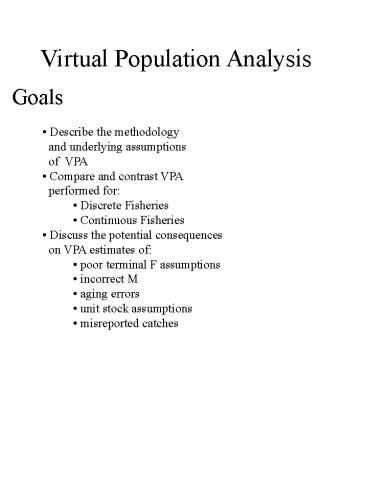Virtual Population Analysis PowerPoint PPT Presentation
1 / 19
Title: Virtual Population Analysis
1
Virtual Population Analysis
- Goals
- Describe the methodology and underlying
assumptions of VPA - Compare and contrast VPA performed for
- Discrete Fisheries
- Continuous Fisheries
- Discuss the potential consequences on VPA
estimates of - poor terminal F assumptions
- incorrect M
- aging errors
- unit stock assumptions
- misreported catches
2
A little nomenclature
Cohort Analysis a.k.a. Virtual Population
Analysis a.k.a. Sequential Population Analysis
- Follows a single cohort
- estimates virtual or unseen population
- looks a sequential catch data
- terms often interchangeable
- based on same general principles
3
Mortality in Review
Nt1 Nt e-(FM)
F instantaneous fishing mortality rate M
instantaneous natural mortality rate
Based on exponential model ofcontinuous
mortality effects.
Numbers
Time
4
When catch-at-age data is availablefor all
fished age classes
Na1,t1 Na,t - Ca,t - Da,t
For time t Na,t - number of age a
(cohort) (unknown) Ca,t - number of age a
caught (fisheries data) Da,t - number dying of
natural causes (estimates or studies)
5
For any single cohort
Time Numbers R ? R1 NR2
CR1 DR1 R2 0 CR2 DR2 R3
all dead in 3 years
- Sum all cohorts for each time
- Virtual Population
- Remember, require
- catch-at-age data
- natural mortality estimates
- Note
- no parameter estimation yet...
- fish accounting
6
VPA In Discrete Fisheries
- Assume F and M occur separately
- brief interception fisheries
- herring, salmon, etc.
- Nt ? less D ? less C ? Nt1??
For each cohort
Nt Nt1 Ct Dt
Dt Nt (1-s)
survival
7
Population at beginning of year (after last
years fishing)
Population prior to fishing (less natural
mortality)
Nt Nt s
Harvest Rate
ht Ct / Nt
Instantaneous Fishing Mortality
Ft -ln(1 - ht)
8
The VPA Result
- provides dynamic
- population
- also harvest rates (by age)
- BUT incomplete cohorts
- not all caught yet
- current pops. not known
- BUT current of most interest!
- see H W p. 353 for herring example
9
Continuous Fisheries
- fishing and natural mortality occurring
continuously throughout the year
Nt1 Nt e-(FM)
proportion of mortalitydue to fishing
We seek an expression of Nt interms of Nt1 ,
M(or s), and Ct asbefore, but ...
10
Pope (1972) derived approximation
Nt Nt1 eM Ct eM/2
- based on instant mid-year fishery
- Works well when (FM) lt 0.7
- error overestimates Nt
- errors accumulate
11
Exact VPA vs Popes Approx.
12
Dealing with Incomplete Cohorts Terminal F
Assumptions
- h, F or N cannot be known for years with
incomplete cohorts - N from other methods
- direct estimates (surveys)
- other statistical methods
- Assume current F values
- estimates of F from auxiliary data
- calculate F from
- nominal effort
- assumed q values (FqE)
Nt Ct (Ft M) (1 - e -Zt ) Ft
Remember Z F M
13
How good is our guess?? Iterated or Tuned VPA
Terminal F Values Converge
14
Caveats for VPA
- commonly used but difficult to refute (lack of
alternatives) - based on only THREE key assumptions
- all fish are dead before some age
- natural mortality is known
- no net em/immigration
- still systematic biases have occurred!!
- Terminal F assumptions
- Incorrect M/ Changing M
- Aging Errors
- Migrations
- Misreporting Fishing Mortality
15
Terminal F Assumptions
- using past F as the current F
- untuned or untested with auxiliary data
- catchability can increase as stock declines
- common in clupeoids
- unrecognized high q will make stock appear
larger than it is - actions
- select terminal Fs to reflect suspected
variations in q - sensitivity to a range of possible q values
- use updated VPAs to examine possible past
biases and trends - newly completed cohorts
16
Incorrect Natural Mortality
- Constant M
- if value used is too large
- estimated cohorts be too large
- assumed mortality not present
- NOTE will assume current cohorts too large!!!
- Changing M
- VPA assumes single, constant M
- time trends in M could generate corresponding,
spurious time trends in estimated abundance - dangerous if using VPA to evaluate past
management actions
17
Aging Errors
- accurate catch-at-age data is the foundation
of VPA - incorrect aging biases cohort age estimates
- asymmetrical
- strong cohorts spill over
- 10 error
- age 2 10, age 3 1000
- estimate age 2 109
- estimate age 3 901
- aging errors mask recruitment variability
- hide relationships
- bias toward indifference to stock size in
management
18
Unit Stock Assumption
- Immigration
- increase in local stock
- worked backward in VPA
- makes cohort appear too large at recruitment
- more serious with older fish
- Emigration
- proportional to stock density
- act like natural mortality
- random
- add noise to any trends
19
Misreporting of Fishing Mortality
- unrecorded landings
- discarding
- fishing-induced mortality
- not catch
- unaccounted for in VPA equations
- if constant, constant bias
- if variable, may mask trends and responses
- Correct VPA calculations with estimated
misreporting

